Question
How many persons sit between J and P when counted from
the left of J? Answer the given questions based on the information given below. Sixteen persons are sitting around the two square tables. One square table is inscribed in another. Two persons sit on each side of the table. The persons on the inner table have different number of balls while the persons on outer table like different colours. J, K, L, M, N, O, P and Q sit on one table while A, B, C, D, E, F, G and H sit on another table. Each of the persons on both tables is facing the closest person opposite to them on different tables such that the persons on inner table are facing outwards while persons on outer table are facing inwards. Persons on inner table have different number of balls from 1 to 8. Also, persons on outer table like different colours among, red, black, pink, yellow, white, grey, blue and green. Note: If A is facing B then both are sitting opposite to each other on the different tables but on the nearest seat. J sits opposite to one, who sits to the immediate left of L, who has 3 balls. Both J and L are sitting on the opposite sides of the same table. The persons facing L is three places away from D. Q has twice number of balls of M, who has 3 balls more than K. K faces E, who likes yellow color. O sits to the immediate right of P, who has 7 balls, on the same side. A, who likes white color, faces O, who has 6 balls. E does not sit adjacent to A or C and K is not adjacent to L. C, who likes green color, sits second to the right of A. G sits to the immediate right of F, who likes red color and both sit on the same side. P has 2 more balls than N, who does not face G. The one, who has 4 balls, faces B, who likes Pink. M is not adjacent to J, who is not to the immediate right of N. G does not like Grey or Blue color.Solution
J sits opposite to one, who sits immediate left of L, who has 3 balls. Also, both sit on same table. The persons facing L is three places away from D. Q has twice number of balls than that of M, who has 3 balls than K. So, K, M and Q have 1, 4 and 8 balls respectively. K faces E, who likes yellow color. O sits immediate right of P, who has 7 balls, on the same side. A, who likes white color, faces O, who has 6 balls. C, who likes green color, sits second to the right of A. G sits to the immediate right of F, who likes red color and both sit on the same side. So, we have four cases, Case-1a 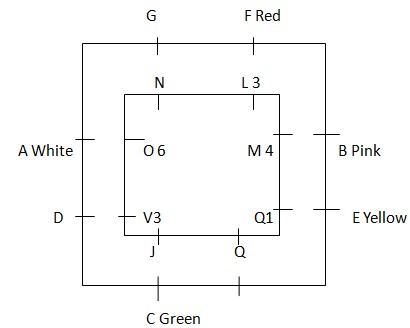 Case-1b
Case-1b 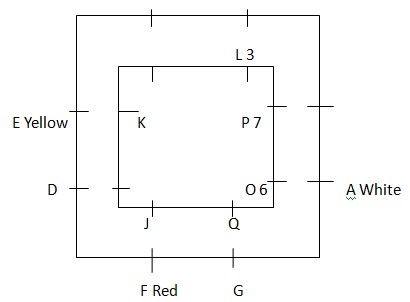 Case-2a
Case-2a 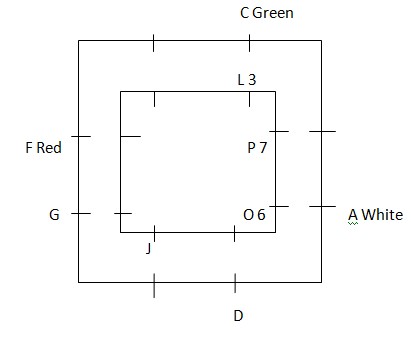 Case-2b
Case-2b 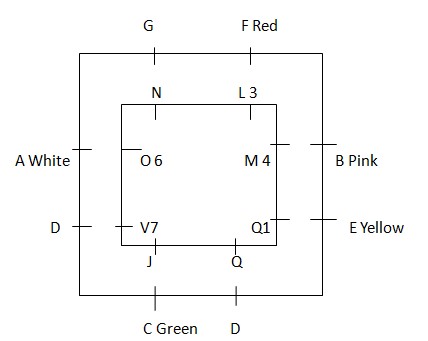 E does not sit adjacent to A or C and K is not adjacent to L. So, case 2(a) is rejected. P has 2 more balls than N, who does not face G. So, case 1(a) and 2(b) are rejected. The one, who has 4 balls, faces B, who likes Pink. M is not adjacent to J, who is not immediate right of N. G does not like Grey or Blue color. So, we have, Case-1b
E does not sit adjacent to A or C and K is not adjacent to L. So, case 2(a) is rejected. P has 2 more balls than N, who does not face G. So, case 1(a) and 2(b) are rejected. The one, who has 4 balls, faces B, who likes Pink. M is not adjacent to J, who is not immediate right of N. G does not like Grey or Blue color. So, we have, Case-1b 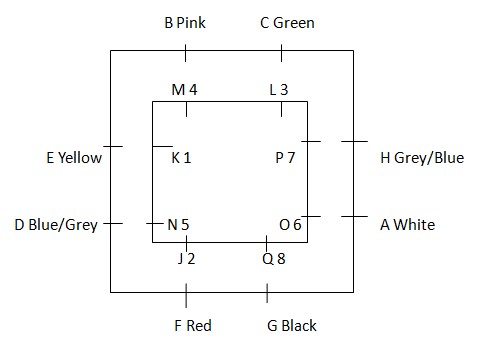
A, B, C, E, D, F are sitting in a row facing towards West. E is not at the right end. B is just right of C but left of F. only D is between A and C. Who...
Who sits 3rd to the right of T?
Seven persons G, H, I, J, K, L and M sit in a straight row facing north direction. I sits third to the left of G. H sits adjacent to G. J sits second t...
Five number-pairs are given, out of which three are alike in certain manner and one is different. Choose the different number-pair.
Who among the following person is sitting exactly between A and D?
Who is third to the left of S?
Six persons D, E, F, G, H and I sit around an equilateral triangular shaped table facing towards the centre. One person sits at each side of the table a...
Who among the following person sits opposite to W?
Who sits opposite to G?
Who sits second to the right of the one who order from Amazon?



